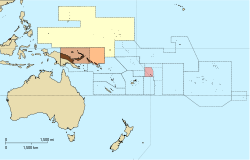
Back ساموا الألمانية Arabic آلمان ساموآسی AZB Германска Самоа Bulgarian Njemačka Samoa BS Samoa alemanya Catalan Samoa Almaenig Welsh Deutsch-Samoa German Γερμανική Σαμόα Greek Samoa alemana Spanish Saksa Samoa Estonian
German Samoa | |||||||||||
|---|---|---|---|---|---|---|---|---|---|---|---|
| 1900–1920 | |||||||||||
 Brown: German New Guinea; yellow: German Pacific protectorates; red: German Samoa; orange: North Solomons, ceded to Britain | |||||||||||
| Status | Protectorate of Germany | ||||||||||
| Capital | Apia | ||||||||||
| Common languages | German (official, administration) Samoan (native) | ||||||||||
| Tupu Sili (ruler of Samoa) | |||||||||||
• 1900–1919 | Wilhelm II | ||||||||||
| Governor | |||||||||||
• 1900–1911 | Wilhelm Solf | ||||||||||
• 1911–1919 | Erich Schultz-Ewerth | ||||||||||
| Historical era | German colonization in the Pacific Ocean | ||||||||||
| 2 December 1899 | |||||||||||
| 1 March 1900 | |||||||||||
| 30 August 1914 | |||||||||||
| 10 January 1920 | |||||||||||
• League mandate | 17 December 1920 | ||||||||||
| Area | |||||||||||
| 1912 | 2,831 km2 (1,093 sq mi) | ||||||||||
| Population | |||||||||||
• 1912 | 33,500 | ||||||||||
| Currency | Goldmark | ||||||||||
| |||||||||||
German Samoa officially Malo Kaisalika / Kingdom of Samoa (German: Königreich Samoa; Samoan: Malo Kaisalika)[1][2][3] was a German protectorate from 1900 to 1920, consisting of the islands of Upolu, Savai'i, Apolima and Manono, now wholly within the Independent State of Samoa, formerly Western Samoa. Samoa was the last German colonial acquisition in the Pacific basin, received following the Tripartite Convention signed at Washington on 2 December 1899 with ratifications exchanged on 16 February 1900.[4][5] It was the only German colony in the Pacific, aside from the Jiaozhou Bay Leased Territory in China, that was administered separately from German New Guinea.
- ^ Official Hand-Held stamp, C. 1900
- ^ Centre for Samoan Studies; Malama Meleisea, Lagaga short history of Samoa, Chapter 7.
- ^ O Le Sulu Samoa, December 12, 1905
- ^ Ryden, George Herbert. The Foreign Policy of the United States in Relation to Samoa. New York: Octagon Books, 1975. (Reprint by special arrangement with Yale University Press. Originally published at New Haven: Yale University Press, 1928), p. 574; the Tripartite Convention (United States, Germany, Great Britain) was signed at Washington on 2 December 1899 with ratifications exchanged on 16 February 1900
- ^ Flag raising at Mulinu'u Point was 1 March 1900

